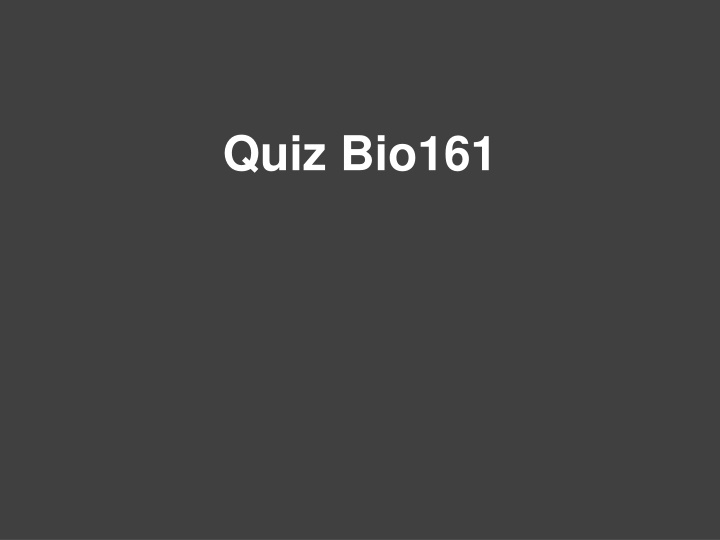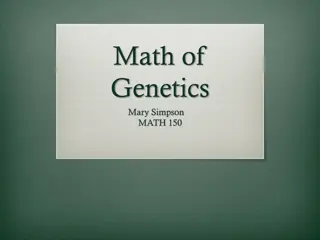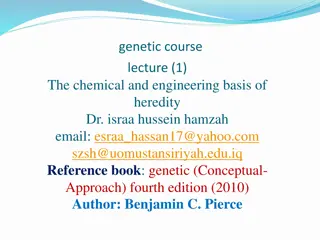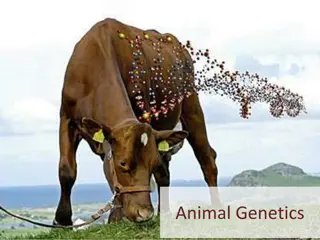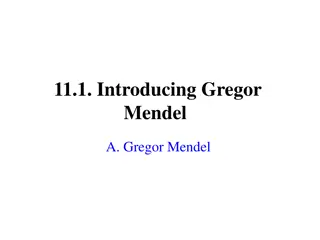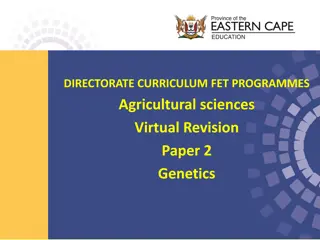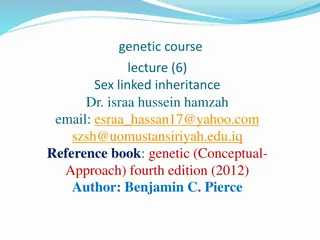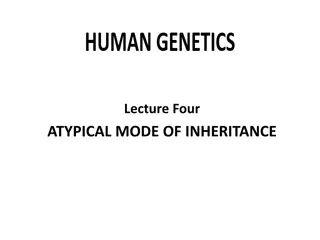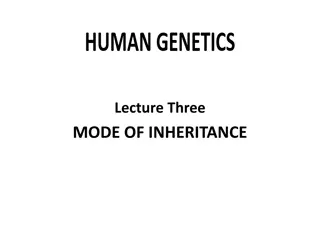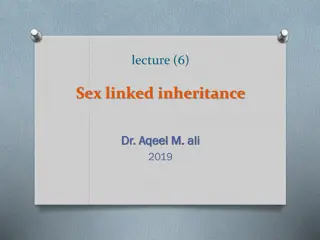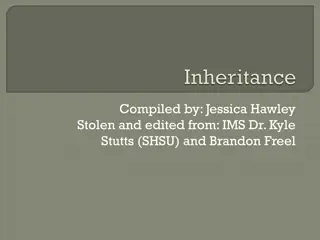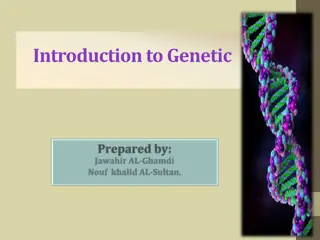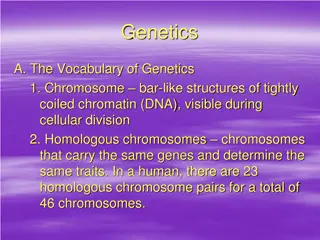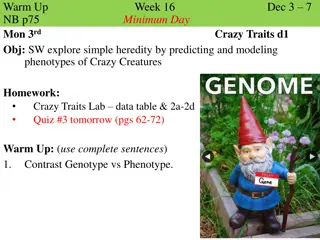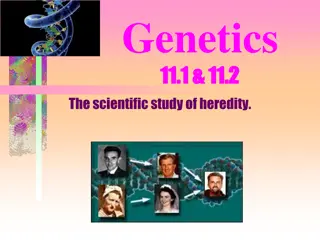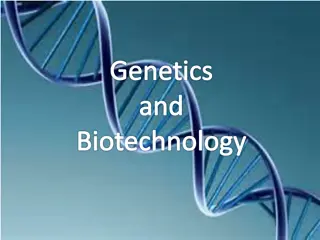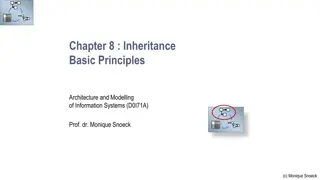Genetics Quiz Questions on Heredity and Inheritance
Test your knowledge on genetics with these quiz questions covering topics like Mendelian laws, dominant and recessive traits, gamete formation probabilities, and genetic crosses. Explore concepts such as allelic inheritance, phenotypic ratios, and genetic probabilities in various scenarios. Improve your understanding of heredity and genetic principles through these challenging questions.
Uploaded on Sep 13, 2024 | 2 Views
Download Presentation

Please find below an Image/Link to download the presentation.
The content on the website is provided AS IS for your information and personal use only. It may not be sold, licensed, or shared on other websites without obtaining consent from the author.If you encounter any issues during the download, it is possible that the publisher has removed the file from their server.
You are allowed to download the files provided on this website for personal or commercial use, subject to the condition that they are used lawfully. All files are the property of their respective owners.
The content on the website is provided AS IS for your information and personal use only. It may not be sold, licensed, or shared on other websites without obtaining consent from the author.
E N D
Presentation Transcript
Q1. The theory that holds that information from the soma is collected in the germ cells or gametes is called A. Pre-formationism. B. Blending theory. C. Spermism. D. Ovism. E. Pangenesis.
Q2. What does the first law of Mendel predict about the gametes of an individual with genotype Aa? A. A and a gametes. B. Aa gametes are formed. C. 3A for every 1a. D. They form a Punnett square. E. AA, Aa, and aa gametes are formed.
Q3. If red is dominant over white and a cross between a white male yields all red offspring, the female must be A. AA. B. Aa. C. aa.
Q4. The distance a red kangaroo can jump is determined by 3 genes (traits) each of which have an allele that contributes to the distance (capital letter) and an allele that does not (small letter). How many distance classes are there among the kangaroos? A. 3. B. 4. C. 5. D. 6. E. 7.
Q5. In a population of fruit flies eye color has 12 different alleles. Any given fly will have ______ copies of eye color. A. 2. B. 4. C. 8. D. 12. E. 24.
Q1. The probability that an individual with the genotype MmNnPp will produce a gamete containing simultaneously M,N, and P is A. 0. B. 1/8. C. 1/4. D. 1/2. E. 1.
Q2. What cross yields a phenotypic ratio of offspring of 3 A-B-, 1 A-bb, 3 aaB-, and 1 aabb? A. AaBb x aabb. B. AaBb x aaBb. C. AaBb x AaBb. D. AaBb x Aabb. E. AaBb x AABb.
Q3. You cross a female with genotype (AabbCc) with a male of genotype (aaBbCc). What is the probability of obtaining an aaB-C- male kitten? A. 3/4. B. 1/8. C. 3/16. D. 3/32. E. 1/64.
Q4. For a penta-hybrid cross you calculate 2 = 7.79. The 2 value for p = 0.05 is 9.488. You A. Accept the model, because p>0.05. B. Accept the model, because p<0.05. C. Reject the model, because p>0.05. D. Reject the model, because p<0.05.
Q5. Leg feathering in chickens is a polygenic trait? A hybrid cross of two chickens with leg feathering produces 15 chicks with and 1 chick without leg feathers. What is the ratio of feathered and non-feathered chicks in the corresponding test cross? A. 1:1. B. 1:1:1:1. C. 9:3:3:1. D. 15:1. E. 3:1.
Q. Antoon van Leeuwenhoek was a(n) A. Pre-formationist. B. Blender. C. Lamarckist. D. Spermist. E. Ovist.
Q. Inheritance of acquired traits is called A. Pre-formationism. B. Blending. C. Spermists. D. Ovists. E. Lamarckism.
Q. Weissman cut the tails of successive generations of mice to disprove A. Pre-formationism. B. Blending. C. Spermism. D. Ovism. E. Lamarckism.
Q. How many genotypically different gametes are formed by AaBbCc? A. 1. B. 2. C. 4. D. 6. E. 8.
Q. What are the gametes produced by AaBb? A. A, B, a, b. B. AA, Aa, aa, BB, Bb, bb. C. AB, Ab, aB, ab. D. A-B-, A-bb, aaB-, aabb.
Q. In turnips, shape is a trait with incomplete dominance between alleles. If a cross between a long and a round turnip yields all oval offspring, the number of alleles is A. 1. B. 2. C. 3.
Q. If a single trait cross yields three different phenotypes, there must be _______ dominance between the alleles. A. complete. B. incomplete C. co- . D. Mendelian. E. Reduction.
Q. A cross resulted in 27 straight-black and 9 curly-red pups. The genotype of the parents is A. AaBb x AaBb. B. AA x aa. C. Aa x aa. D. Aa x Aa. E. Aa x aa.
Q. The distance red kangaroos of a population jump forms a bell-shaped curve. Distant jumped is a A. Dominant trait. B. Co-dominant trait. C. Polymorphic trait. D. Mendelian trait. E. Polygenic trait.
Q. Traits that have more than two alternative forms are called A. Polygenic. B. Polymorphic. C. Polyarchic. D. Polyarthritic. E. Polyphenic.
Q. The cross that yields half of the offspring with the parental and half with the heterozygous phenotype is A. AA x aa. B. AA x Aa. C. Aa x Aa. D. aa x aa. E. Aa x bb.
Q. In horses, a chestnut stallion and a white mare have a roan foal. Between the coat color alleles there is A. Complete dominance. B. Polygenic dominance. C. Polymorphic dominance. D. Incomplete dominance. E. Co-dominance.
Q. If the alleles of a trait are co-dominant what is the df of the corresponding 2 test? A. 1. B. 2. C. 3.
Q. How many terms are there in 2 of a monohybrid cross with incomplete dominance between the alleles? A. 1. B. 2. C. 3. D. 4. E. 5.
Q. A true-breeding plant is one that A. Produces offspring that are different from the parents. B. Forms hybrid offspring through cross pollination. C. Produces offspring that are always the same as the parents. D. Can only reproduce with itself. E. Produces offspring that never lie.
Q. A true-breeding plant is one What property distinguishes Mendel s investigation from previous studies? He A. Used true-breeding pea plants. B. Quantified his results. C. Examined many different traits. D. Examined the segregation of traits. E. As amonk, he prayed a lot.
Q. Alternative forms of genetic information for a trait are called A. alleles. B. Genes. C. Factors. D. Heterozugotes. E. Diploids.
Q. When Mendel crosses yellow and green peas all the offspring were yellow. What was actually transmitted from parents to offspring? A. B. A fluid called a gemule . Similarity in appearance, size and other features. Specialized cells of different organs and structures of the parent plants. Yellow and green pigment. Encoded information that determines the potential to develop pea color. C. D. E.
Q. A An organisms ____ is determined by its _______ A. Allelotype; genotype. B. Genotype; phenotype. C. Genotype; allelotype. D. Phenotype; genotype. E. Allelotype; phenotype.
Q. Which of the crosses produces progeny of the recessive phenotype? A. Ww x WW. B. WW x ww. C. WW x Ww. D. WW x WW. E. Ww x Ww.
Q. The shape of radishes may be long, round, or oval. A cross between long and round radishes produces oval offspring. The phenotypic ratio of the offspring of a cross between two oval-shaped parents is A. 1 round: 2 oval: 1 long. B. 1 long: 2 round: 1 oval. C. 1 round: 2 long: 1 oval. D. 3 long: 1 round. E. 2 oval: 2 round.
Q. The coat color of the rabbit can be black, brown, gray, silver, himalayan, or albino. Of the coat color trait any given rabbit may have as genotype A. None of the different alleles. B. A single allele. C. Only 2 of the different alleles. D. Any combination of 1, 2, or more of the different alleles. E. All the different alleles.
Q. If two individuals heterozygius for two genes are crossed, this would be called a A. Double zygote cross. B. Hybrid cross. C. Test cross. D. Dihybrid cross. E. F1 cross.
Q. The observable outward manifestation of the genes of an individual is referred to as its A. Genotype. B. phenotype. C. archetype. D. idiotype. E. Morphotype.
Q. Co-dominance reflects the interaction between alleles of A. A single trait. B. Different traits. C. Many traits. D. Dominant traits. E. Recessive traits.
Q. Whereas organisms are _____ their gametes are _____. A. Diploid; polyploid. B. Polyploid; haploid. C. Polyploid; diploid. D. Diploid; haploid. E. Big, small.
Q. By shopping off the tails of several generations of mice, August Weismann dispelled with the _______ theory. A. Inheritance. B. Preformationism. C. Ovism. D. Evolution. E. Lamarckism. F. Blending. G. Mendel.
Q. What is the probability that an offspring of a trihybrid cross will have the phenotype aqaB-cc? A. 3/64. B. 9/16. C. 1/64. D. 5/12. E. 27/64.
Q. A phenotype that shows continuous variation among the individuals of a population is called A. Polymorphic. B. Polygenic. C. Polyploid. D. Dominant. E. Pleiotrophic.
Q. If a population contains 75 short-haired and 25 long-haired cats, the frequency of the recessive allele (long-hair) of the parents is A. 0.75. B. 0.25. C. 0.50. D. 0.05. E. 1.00.
Q. In hamsters black is dominant over brown. Allele frequency of black is 0.4 and of brown is 0.6. How many brown animals do you expect in next year s population of 100 animals? A. 16. B. 36. C. 60. D. 84. E. 75.
Q. In hamsters black is dominant over brown. Allele frequency of black is 0.4 and of brown is 0.6. How many black animals do you expect in next year s population of 100 animals? A. 16. B. 36. C. 60. D. 84. E. 75.
Q. You have compared the phenotypic ratio of the offspring to that predicted by a dihybrid cross. You calculated P>0.05. P is the probability A. With which the dihybrid model by chance alone correctly explains the cross. That you are correct by chance alone when you accept the results of the test. Of obtaining a dominant phenotype in a dihybrid cross. With which observed and predicted number of phenotypes differ by chance alone. Of obtaining by chance alone a chi-square value such as you calculated between observed and predicted values. B. C. D. E.
